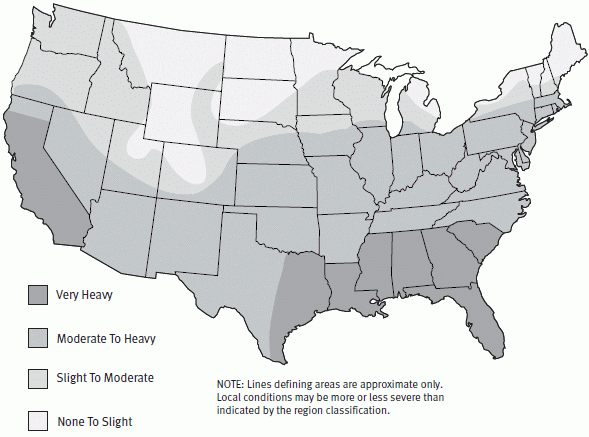Design Criteria covers site conditions and describes features and issues that are characteristic of the building site. These are factors that shape decisions about the foundation and over which the installer, designer, builder, or developer have little or no say. Each site comes with its own set of such conditions and these features vary from site to site and region to region. These “givens” begin to suggest the better foundation systems for a specific site.
Design Criteria
-
Codes
-
Soil Types
-
Frost Heave
-
Flood Hazard
-
Wind
-
Seismic
-
Snow
-
Termites
As opposed to the HUD code for the construction of manufactured homes at the factory, which is preemptive of local codes and creates uniformity of manufactured home construction across state lines, foundation systems are subject to state or local building codes. So, while the homes themselves may enjoy consistency of design and construction, foundation plans are subject to review by the local code enforcement authorities.
In and every mobile home foundation must be tailored to local site specific conditions. Local building department approval is almost always required, and the use of professional engineer firm (like us) to prepare plans for submission is prudent and is also required for HUD/FHA/VA-insured financing.
Major Soil Types
Characteristics of major soil types
The United States has a wide variety of soils. Since it is the soil that supports the home, understanding the properties of different soil types is fundamental to sound foundation selection and design (see table below).
Certain soils have relatively little ability to support weight. Some become more or less supportive when wet or dry. Others may expand or shrink when moisture is present. Some soils will compact well, and others won't. Whatever the soil condition, knowledge of foundation system alternatives can help save money and possibly contribute to the long-term durability of the home.
Knowledge of these general soil types and knowing how these soil properties impact the foundation design is why you need our professional engineering services. We incorporate this important informatin into your foundation design so that the contractor and others involved in the home installation, including retailers and installers can do their job properly. In most cases it isn't necessary to make a detailed analysis of the soil types. However, we do pay careful attention to the impact that unusual or troublesome soils can have on your mobile home.
| Soil Description | Value as a foundation material | Drainage characteristics1 | Susceptibility to frost heave | Volume change potential expansion2 |
| Well-graded gravels, gravel-sand mixtures, little or no fines | Excellent | Good | Low | Low |
| Poorly graded gravels or gravel-sand mixtures, litttle or no fines | Good | Good | Low | Low |
| Well-graded sands, gravelly sands, little or no fines | Good | Good | Low | Low |
| Poorly graded sands or gravelly sands, little or no fines | Good | Good | Low | Low |
| Silty gravels, gravel-sand-silt mixtures | Good | Good | Medium | Low |
| Clayey gravels, gravel-sand-clay mixtures | Good | Medium | Medium | Low |
| Silty sand, sand-silt mixtures | Fair | Good | Medium | Low |
| Clayey gravels, sand-clay mixture | Fair | Medium | Medium | Low |
| Inorganic silts and very fine sands, rock flour, silty or clayey fine sands or clayey silts with slight plasticity | Fair | Medium | High | Low |
| Inorganic clays of low to medium plasticity, gravelly clays, sandy clays, silty clays, lean clays | Fair | Medium | Medium | Medium to low |
| Inorganic silts, micaceous or diatomaceous fine sandy or silty soils, elastic silts | Poor | Poor | High | High |
| Organic silts and organic silty clays of low plasticity | Poor | Poor | Medium | Medium |
| Inorganic clays of high plasticity, fat clays | Very Poor | Poor | Medium | High |
| Organic clays of medium to high plasticity, organic silts | Very Poor | Unsatisfactory | Medium | High |
| Peat and other highly organic soils | Not suitable | Unsatisfactory | Medium | High |
1. The percolation rate for good drainage is over 4 in. per hour, medium drainage is 2 to 4 in. per hour, and poor is less than 2 in. per hour.
2. Soils with a low potential expansion typically have a plasticity index (PI) of 0 to 15, soils with a medium potential expansion have a PI of 10 to 35, and soils with a high potential expansion have a PI greater than 20.
Expansive Soils
One important measure of the ability of soil to support the weight of the home is its bearing capacity, a value representing the weight that one sq ft of earth surface is capable of supporting without risk of subsiding. This information may already be available from the local building department or from a local engineer. Values range from less than 1,000 lbs per square foot (psf) to more than 4,000 psf.
Other problems can arise when foundation systems are placed on soils that contain a high percentage of organic matter or on fill soil. Excessive organic matter should be removed and fill properly compacted.
Special mention should be made of a broad group of "expansive" soils. Expansive soils significantly change volume as they absorb water. Highly active soils (see map below) are particularly prone to shifting as water content rises and falls. Special building practices have been developed for homes located in areas with expansive soils. These are areas where local engineers should be consulted before designing a foundation system. Slabs-on-grade foundation systems are often desirable in areas with expansive soils.
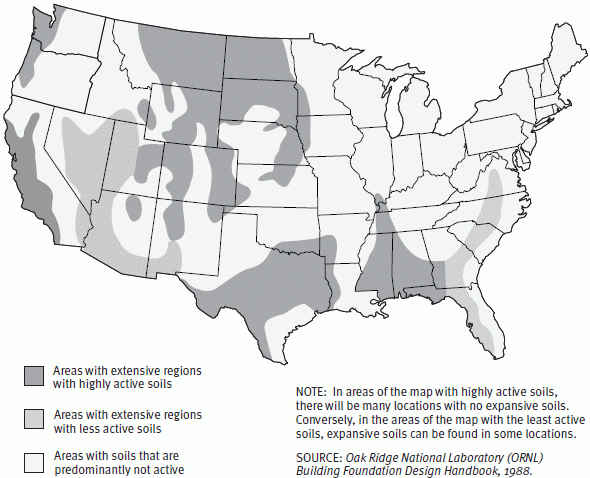
Frost is a critical element in foundation system selection and design in many parts of the country. Frost depth is simply the known depth in the ground to which water in the soil is known to freeze. The maximum frost depth (also known as frost line) is often displayed on isobar maps (see map below). Local building codes generally indicate the frost depth to which a foundation must be excavated to reach below the frost line.
When water in the soil freezes, it expands and may cause the structure above it to shift (heave). This can affect any building resting on such ground.
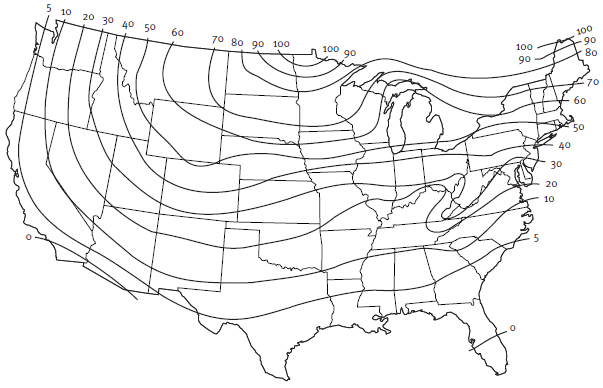
Unless proper precautions are taken, homes located in low-lying sites near waterways or along the coasts are at risk of flood damage. Riverine flooding takes place when excessive runoff causes a stream or river to overflow its normal channel. Coastal flooding normally is the result of ocean storms, which can be severe.
Flood hazard areas are referred to as flood plains. Flood plains, outside the floodway, may become inundated with rising water that has little or no movement. It is possible to minimize or eliminate the risk of damage to homes located in the flood plain. A flood plain may, however, contain floodways, an identified area where the risk of damage from moving water and the debris that it may carry is so great that it prohibits residential construction.
The first step when dealing with a building site within a flood plain is to verify that it is outside of the floodway. The Federal Emergency Management Agency (FEMA) and its local flood plain administrator are the best sources of information regarding the history of local floods and potential for flood damage.
In addition to identifying areas subject to varying degrees of flood severity, FEMA's flood maps are used to determine zones for National Flood Insurance Program (NFIP) premium rates. In a flood plain, the lowest floor is located at or above the Base Flood Elevation (BFE). The BFE, also referred to as "100-year flood" level, is indicated on the Flood Insurance Rate Map (FIRM) available from the local FEMA administrator. FEMA's flood maps indicate the areas where the land is below the BFE. New homes installed with the first floor (including a basement floor) below the BFE are ineligible for the NFIP rates (certain exceptions apply; consult 44 CFR 60.3, local flood plain ordinance). In most cases, homes below the BFE ineligible for any form of federally supported financing and other types of disaster assistance.
If properly designed, crawl space foundation systems can be used in flood plains. Other suitable foundation systems include reinforced piers and pile foundation systems. Basements, by definition, involve substantial excavation and the creation of below-grade living areas. This automatically disqualifies them from participating in the NFIP. Finally, slabs may be acceptable, assuming the home itself is sufficiently elevated above the ground.
The southeast coast of the United States is prone to tropical storms and hurricanes. Foundation design and selection in these areas is often subject to local code wind speed minimums (see map below). Where hurricanes are common, the selection of a foundation system must take into consideration its ability to hold a home down in hurricane winds.
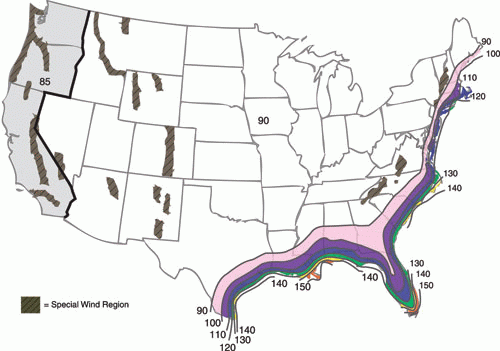
Parts of the West Coast, and certain other mid-continent locations are subject to earthquakes that can move a home off its foundation (see map below). Since HUD-code homes are engineered to resist the severe forces and stresses that occur during transportation at highway speeds, they are particularly well suited to survive earthquakes with little damage.
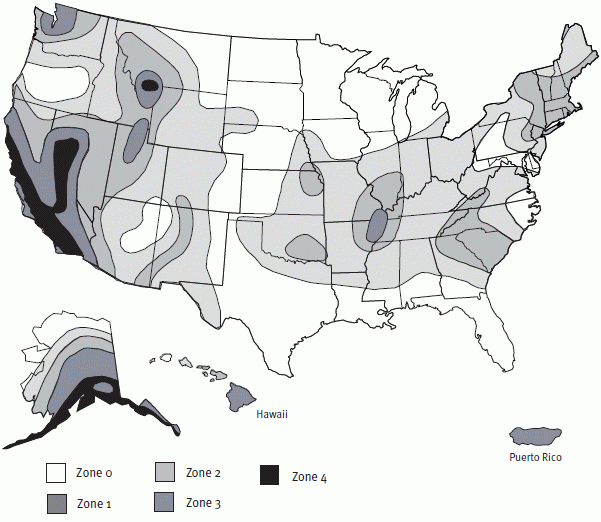
Snowfall in northern and mountain regions can impose a heavy load on a roof and through a structure to its foundation (see map below). The locally mandated roof snow load requirements should be checked. The foundation selected must support the home with of the specified extra weight from snow and ice.
Homes designed with a minimum snow (or "live") load (20 psf) often do not require any perimeter wall support. As the roof live load capacities increase, manufacturers typically require that the home be supported along the perimeter with blocking. As the design load increases so does the number of such support points. One of the methods manufacturers may require is additional support under the edges of doors and large windows.
The manufacturer's specifications describing methods to support the higher roof design loads are quite easy to incorporate into most of the foundation systems described in this guide. The contractor should verify and reconcile the snow load requirements, the manufacturer's instructions, and the foundation design.
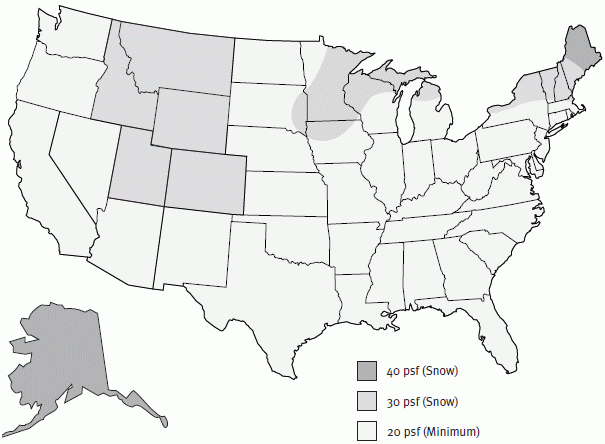
Termites represent a threat to wood buildings almost everywhere, although the problem is particularly acute in some areas of the southeastern states and Hawaii (see map below). The use of steel, concrete, and pressure-treated lumber can minimize the damage caused by these pests. There are good termite shield designs that can be incorporated into most foundation systems in areas of especially high infestations of termites. Most shields are constructed from lengths of galvanized steel inserted between the concrete and wood portions of the foundation. The steel protrudes outward and downward, creating a barrier to termite mud tubes.
In termite-prone areas, the design and construction of the foundation system should assure that there is no contact between untreated wood components of the foundation and the ground. Good workmanship would also entail cleaning up all wood scraps from the job site.
